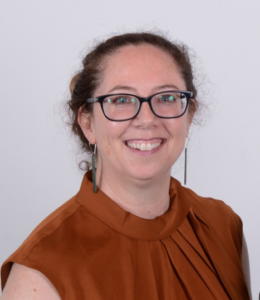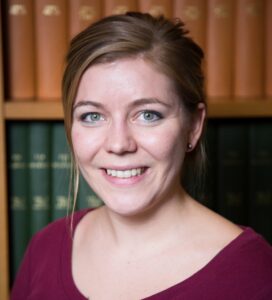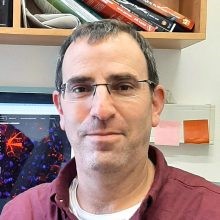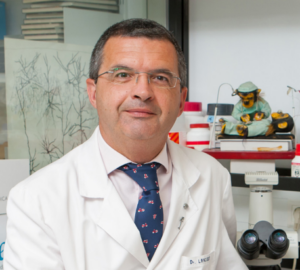
I am a Professor of Experimental Medical Research at Lund University. After studying Medicine and Neurology in Italy, I moved to Sweden to pursue basic and translational research on basal ganglia disorders (particularly on Parkinson’s disease). To this end, our group developed rodent models reproducing key features of human movement disorders and used these models to uncover basic disease mechanisms and therapeutic targets. I have commissions of trust at several national and international organisations that support translational research on Parkinson’s disease and related disorders.

We study molecular and signal transduction mechanisms underlying neurotransmission in the basal ganglia. During the last two decades we identified key molecular events involved in the effects of various classes of drugs, including addictive substances and antipsychotic medications. We are also studying signal transduction abnormalities linked to motor and psychiatric complications caused by prolonged administration of antiparkinsonian drugs. More recently, we developed models of Parkinson’s disease to study the molecular and network alterations at the basis of non-motor symptoms, which include cognitive and affective disorders.

Our research program aims at elucidating the neuroplasticity of cortical and subcortical brain circuits associated with the development of parkinsonism in nonhuman primate models of Parkinson’s disease.

John Reynolds initially had careers in medical electronics and then clinical Medicine and then completed a PhD in Neuroscience at University of Otago. His focus is in vivo approaches to brain disorders, learning models and circuit connectivity using electrophysiological recording methods and behavioural analyses. His interests have been in synaptic plasticity recorded in single neurons in the basal ganglia and in the role of dopamine and acetylcholine in the whole animal. He has recently extended this work to translational approaches to Parkinson’s disease in rodent and sheep models and is developing advanced neurostimulation and drug delivery approaches for progressive translation to humans.

Louise Parr-Brownlie (Ngāti Maniapoto me Te Arawa) was a postdoctoral fellow at the National Institutes of Health in the United States before joining the Department of Anatomy at the University of Otago in 2010. Louise is a neurophysiologist investigating how neuronal activity in the basal ganglia, motor thalamus and motor cortex controls movement, and characterising changes associated with Parkinson’s disease. Recently, she has investigated the utility of optogenetic stimulation applied to the motor thalamus to recover movements in parkinsonian models. Louise has also worked with bioengineers to develop an implantable light-based device for continuous brain stimulation over 6 months, which is commercially available.

I am a Professor of Laboratory of Histology and Cytology, Faculty of Medicine at Hokkaido University. After working as a neurologist, I switched to basic research. Our research group is introducing a variety of experimental methods using morphology, electrophysiology, and genetic engineering. Examples include specific neuron labeling with recombinant viral vectors, neural reconstruction using confocal laser microscopy and neurolsida, in vitro whole cell patch clamp recording and in vivo electrophysiological and behavioral experiments combined with optogenetics. By combining static approaches with dynamic ones, we hope to contribute to the understanding of the pathophysiology of neurodegenerative diseases in which specific nerve systems are injured and to their therapeutic applications.

I am a Scientific Advisor at MIT with a background in the molecular and anatomical bases of basal ganglia function and dysfunction. My areas of focus, with an eye to public outreach, now include basal ganglia disorders, addiction, brain-body interactions and neurotechnology.

Nicole Calakos, M.D., Ph.D. is a physician-scientist who cares for patients with Movement Disorders and maintains an active laboratory research program. Dr. Calakos is the Lincoln Financial Group Professor of Neurology and Neurobiology and Chief of the Movement Disorders section in Neurology at Duke University Medical Center. Her laboratory studies how synaptic plasticity generates learning and adaptive behavior; and how its disruption causes diseases of the basal ganglia circuitry. The Calakos lab is widely recognized for its contributions to understanding habit formation, compulsive behavior and dystonia and for the generation of new methodologies to study basal ganglia physiology.
Dr. Calakos received her bachelor’s degree from the University of California at Berkeley, her M.D. and Ph.D. degrees from Stanford University, and residency training in Neurology at the University of California at San Francisco.
Dr. Calakos’ contributions have been recognized through a number of awards, leadership and service opportunities. Dr. Calakos advocates for basic and translational neuroscience through activities that have included: the Board of Directors for the American Neurological Association, Governance Committee for the Duke Institute for Brain Sciences, NIH study sections, and scientific advisory boards for Tourette’s Syndrome and Dystonia.
https://www.neuro.duke.edu/research/faculty-labs/calakos-lab

My research centres on the synaptic connectivity of inputs to, and nuclei within, the basal ganglia. My work also aims to determine network, cellular and molecular pathological changes underlying disease. After receiving my B.Sc. from the University of Otago in Dunedin, NZ, I joined the lab of Prof Paul Bolam at the University of Oxford. My thesis work focused on defining the cortical and thalamic inputs to striatal projection neurons and interneurons using anatomical and electrophysiological techniques. I returned to Oxford in 2014 to work with Prof Peter Magill to define the molecular and structural properties of distinct cell types in the basal ganglia and their partner brain circuits.

I am a Physiology Full Professor af the Department of Physiology at Dental School of Ribeirao Preto, University of São Paulo since 2013. My interest is in unveiling new mechanisms involved in the pathophysiology of neurodegenerative and mental disorders such as Parkinson’s disease and schizophrenia. We for example have shown that cannabinoid system abnormalities could be associated with sensorimotor gating deficits observed in schizophrenic patients and that the nitric oxide synthase inhibitors (iNOS) and the antibiotic doxycycline prevents degeneration of dopamine neurons.

Our lab studies cellular and network physiology of basal gangalia and brain stem circuits in rodent models of movement disorders, with an emphasis in recent years on the pathophysiology of prodromal symptoms of PD. We combine slice electrophsyiolgy in conjunction with multphoton imaging and optogenetics, endoscopic imaging and mathemaical modeling.

Dr. Christelle Baunez, is Directrice de Recherche at the CNRS, leader of the team ‘Basal Ganglia, Motivation and Reward’ (BAGAMORE) at the Institut de Neurosciences de la Timone (INT) in Marseille (France). During her PhD thesis in Marseille on behavioral studies of pharmacological interactions between glutamate and dopamine within the basal ganglia, she started to be interested in the subthalamic nucleus (STN) as a possible target for the treatment of Parkinson’s disease. During her post-doctoral internship at Cambridge University (UK) (supervised by Prof. T.W. Robbins), she focused on the involvement of the STN in non-motor functions. She revealed the involvement of STN in attention and control of inhibition. She got her permanent position at the CNRS in 1997 and pursued her research on the functions of the STN, developing deep brain stimulation in behaving rats. One of her major finding, published in Nature Neuroscience in 2005 and PNAS in 2010, was to show that STN lesion or DBS reduces motivation for cocaine, while increasing motivation for food, suggesting that STN DBS could be applied to treat addiction. The research in her team extends to non-human primate and parkinsonian patients and is mainly focused on motivation.
She has published 69 articles in international journals and 8 book chapters. She has been invited to present her work at 102 international (71) and national (31) symposia. She has co-organized international meetings and symposia in international meetings. She has been awarded various international and national fundings and prizes. She has recently served as president of the scientific council of the Institute for Life sciences at the CNRS. She is Principal Editor for Psychopharmacology. She is member of the board of various international societies (EBPS, EWCBR, IBAGS) and is currently president of the scientific council of France Parkinson Association. She is very active at teaching and mentoring students at various levels. Has been part of many boards of grant reviews and PhD committees.

After completion of her Ph.D. in Neuroscience at UCM (Universidad Complutense de Madrid, Spain), Ledia received a Fulbright grant to pursue postdoctoral training in Ann Graybiel´s Lab at MIT, where she studied the role of striatal dopamine in learning and habitual behaviour. As an investigator in Spain, her research is focused on Parkinson’s Disease. She is currently testing a novel hypothesis for what might cause this disease: the continuous engagement of dopamine neurons in the substantia nigra pars compacta (SNc) in habitual behaviour as a significant stressor for this vulnerable neuronal group (Hernandez et al, TINS, 2019). She has received European (Marie Slodowska-Curie grant) and national funding to pursue her research.
Toward a deeper understanding of the role of each striatal pathway in movement control and levodopa induced dyskinesias (LIDs), Ledia recently developed a new animal model using optogenetics to evoke “optodyskinesias” in normal and dopamine depleted states. Currently, she is developing strategies to prevent LIDs and deepen the knowledge behind the selective and early onset loss of dopaminergic neurons in the SNc.

I am an Associate Professor of Neurosciences at the University of Navarra and a Staff Scientist at the Center for Applied Medical Research (Cima). My research team focuses on translational research in the field of Parkinson’s disease and related synucleinopathies by taking advantage of gene therapy tools. Since December 2006 our group has been recognized as “group of excellence” by the Spanish Ministry of Health, therefore joining the so-called Research Network Center in Neurodegenerative Disorders (CiberNed) as a founding member.

I am a clinician scientist (MD) at the Movement Disorders and Neuromodulation Unit at Charité Berlin. I have built an expertise in movement disorders, neurophysiology and deep brain stimulation. My strengths are the implementation of methods for multimodal and multidimensional data analysis for clinical neuroscience applications. My current work combines computational modelling, machine and deep learning, structural and functional connectomics (fMRI), invasive (LFP/ECoG) and non-invasive (EEG/MEG) neurophysiology, to develop the next-generation of intelligent clinical brain computer interfaces for patients with movement disorders.

I am a tenured researcher at INSERM (National institute of Health and medical research) and team leader at CNRS (National Center for scientific research) in Bron, France. After studying neurosciences in France, Canada and United States, I came back to France to study Parkinson’s disease. My research focuses on the pathophysiology of motor and non-motor symptoms of Parkinson’s disease, combining a clinical approach in patients and a preclinical approach in animals.

Raffaella Tonini leads the Neuromodulation of Cortical and Subcortical Circuits Lab, at the Italian Institute of Technology (IIT), Italy. Her research goal is to understand how the brain learns to cope with an ever-changing environment and to choose between different behavioral options. Within this context, her research team focuses on the role of neuromodulatory substances in shaping micro- and macro circuit interactions to ultimately report selective perceptual and motivational information over multiple timescales.